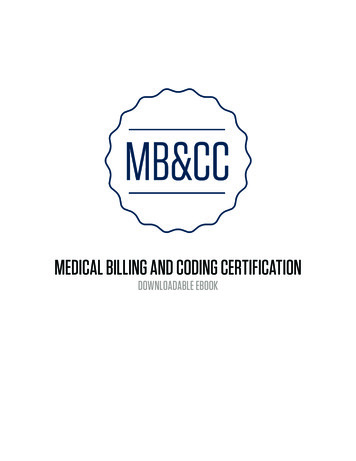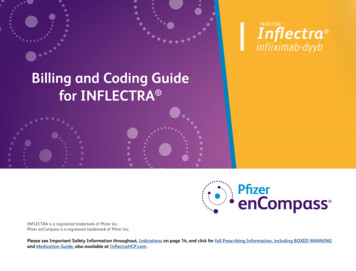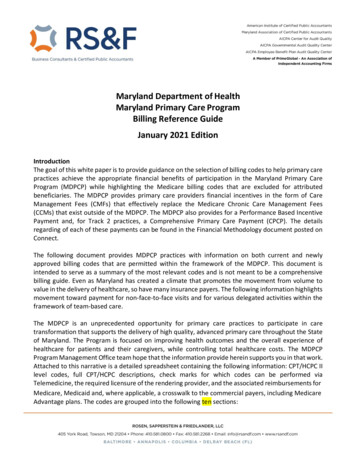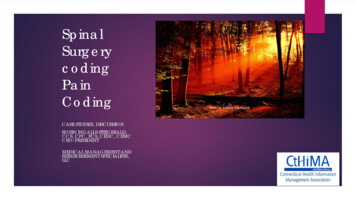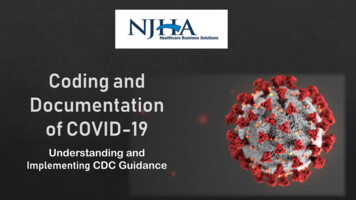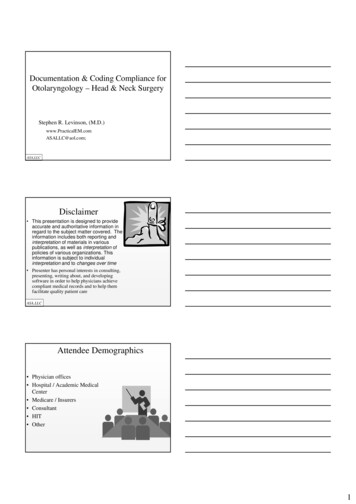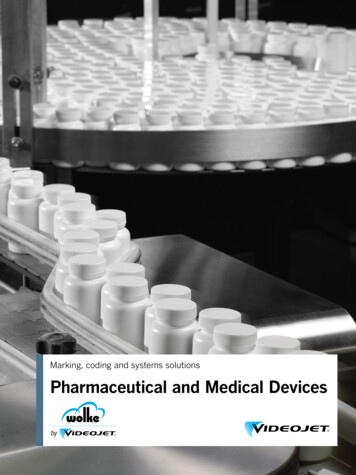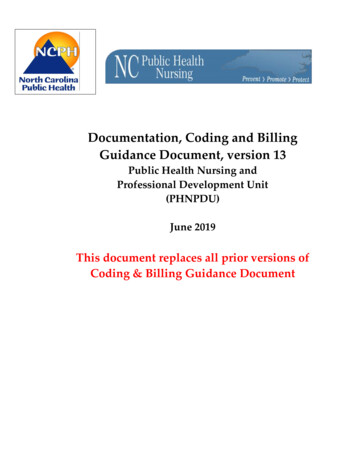
Transcription
- Documentation, Coding and BillingGuidance Document, version 13Public Health Nursing andProfessional Development Unit(PHNPDU)June 2019This document replaces all prior versions ofCoding & Billing Guidance Document
ContentsIntroduction . 4General Information . 4Documentation. 4Billing. 7Standing Orders . 12Sliding Fee Scale . 12Identifying Program Type. 13Establishing Fees . 14ICD Coding Resources . 16Program Specific Guidelines. 17Child Health (CH) . 17Immunization Program . 33Sexually Transmitted Infections . 43STI LABS . 47Tuberculosis Control & Treatment . 51Communicable Disease . 56Women’s Health . 57Maternity/OB Billing . 57Family Planning 80Pharmacy (related to Family Planning) . 114Laboratory . 121Medical Nutrition Therapy (MNT). 126WIC Program . 128Telemedicine & Telepsychiatry . 129Local Use Codes . 129Adult Health . 130WISEWOMAN/Breast & Cervical Cancer Control Program (BCCCP) . 131Dental Services . 131Medicaid Specific Modifiers . 132Contacts: . 137Appendices. 138CBGD PHNPDU 062019, v1302
Appendix A Flow Chart for LHD Billing by Client Types . 138Appendix B Flow Chart for LHD Billing by Client Types . 139Glossary . 143Quick Links . 147CBGD PHNPDU 062019, v1303
IntroductionThis document was developed to provide local health departments (LHD) with guidance andresources specific to public health coding and billing of services rendered. This information wasdeveloped using current program Agreement Addenda, Medicaid bulletins and ClinicalCoverage Policies, and Current Procedural Terminology (CPT) and International Classification ofDiseases or Diagnosis (ICD-10) code books. Although we have made every attempt to providecomprehensive and correct information, it is still advisable to contact your program consultantsif this information is unclear or if you have specific questions.General InformationDocumentation1. Documentation within the health record must support the procedures, services, and suppliescoded.2. Accuracy, completeness, and timely documentation are essential, and agencies should havea policy that outlines these details. Please refer to the Documentation Guidance from LocalTechnical Assistance and Training (LTAT) Branch Head (http://publichealth.nc.gov/lhd/) foradditional information and guidelines.3. If there is insufficient documentation to support claims that have already been paid, thereimbursement will be considered overpayment and a refund will be requested.Medicaid payment process through NC Tracks: June 2015Electronic adjustments are the preferred method to report an overpayment orunderpayment to DHB. There are two separate actions that may be filed: A provider should use "void" when the client needs to cancel or submit a refundfor a previously paid claim. The entire claim will be recouped under the voidprocess. A provider should "replace" a claim if the client is updating claim information orchanging incorrectly billed information. This term is interchangeable withadjusting a claim. The entire claim will be recouped and reprocessed under the replacement.4. CMS guidelines require that the chief complaint/reason for a visit is documented in therecord. In most cases it will be a complaint of a symptom but could be “annual Family Planning(FP) exam” or “Health Check exam”. Remember that the client may present on the day of a visit with a differentreason/chief complaint from the one identified when the appointment was made.CBGD PHNPDU 062019, v1304
In some cases, the Physician or Advanced Practice Practitioner may change the “chiefcomplaint” if, during the exam, a significant problem is identified that must beaddressed during the visit.5. New versus Established client: A new client is defined as one who has not received any professional services from aphysician/qualified health care professional working in your health department, withinthe last three years, for a billable visit. This includes some level of evaluation and management (E/M) service coded as apreventive service using 99381-99387 or 99391-99397 Or as an evaluation & management service using 99201-99205 and 99211-99215.If the client’s only visit to the Health Department is WIC or immunizations without one ofthe above service codes It does not affect the designation of the client as a new client; the client can still beNEW. Remember that a client may be new to a program but established to the healthdepartment if they have received any professional services from a physician/qualifiedhealth care professional. In this case, you would use the forms for a “new” client for that program even thoughthe client is billed as “established” to the health department.Due to National Correct Coding Initiative (NCCI) edits the practice of billing a 99211, andthen later billing a new visit code, has been eliminated. Many LHDs have been billing a 99211 (usually an RN only visit) the first time they see aclient and then, up to 3 years later, bills a 99201 – 99205 or 99381-99387 (New Visit). Examples may include: billing the 99211 for pregnancy test counseling or head licecheck by RN and then a new visit when the client comes in for their first prenatal, FamilyPlanning or Child Health visit. Now that the NCCI edits have been implemented, all of those “new” visits will denybecause the LHD will have told the system (via billing a 99211) that the client is“established.”Consult your PHNPDU Nursing Consultant if you have questions.CBGD PHNPDU 062019, v1305
6. Shared/split E/M Visits (January 2017 Medicaid Bulletin- pg. 14) A shared/split Evaluation and Management (E/M) visit is defined as a medicallynecessary encounter with a client where the physician and a qualified Non-PhysicianPractitioner (NPP) each personally perform a substantive portion of a face-to-face E/Mvisit with the same client on the same date of service. A “substantive portion” of an E/M visit involves all or some portion of the history, examor medical decision-making key components of an E/M service. The physician and the qualified NPP must be in the same group practice or be employedby the same employer. Note: [NPP includes the terms “mid-level provider”, “NursePractitioner (NP)”, “Physician Assistant (PA)” and Certified Nurse Midwife (CNM) (alsoacceptable is APP-Advance Practice Practitioner). Every party must document the work they performed. The documentation must show aface-to-face encounter with the physician, in which case the service is billed under thephysician’s National Provider Identifier (NPI). If there is no face-to-face encounter with the physician, the NPP must bill the serviceusing the NPP’s National Provider Identifier (NPI). A notation of “seen and agreed” or “agree with above” would not qualify the situationas a shared/split visit because these statements do not support a face-to-face contactwith the physician. Only the NPP could bill for the services.According to the Centers for Medicare & Medicaid Services (CMS), shared/split visitsare applicable for services rendered in the following settings: Hospital inpatient or outpatient Emergency department Hospital observation Hospital discharge Office or clinicAccording to the Centers for Medicare & Medicaid Services (CMS), shared/split visitsare not allowed: In a skilled nursing facility or nursing facility setting For consultation services For critical care services (99291-99292) For procedures In a client’s home or domiciliary siteNOTE* Shared/split visits are not considered “incident to” services.CBGD PHNPDU 062019, v1306
Billing1. LHDs bill for services using the NPI of the Physician or Advanced Practice Practitioner whoprovided services to the client or for the Medical Director who signed the standing orders forthe nurse to provide the service.2. Services provided by nurses (including Enhanced Role Registered Nurses) should be billedusing the NPI of the physician who wrote the standing order to provide the examination.3. Nurses providing services for which they would bill a 99211 should bill that visit under theMedical Director’s NPI unless there is a specific order from another physician for that client tosupport the visit.4. To be eligible to bill for procedures, products, and services related to this policy, Physician orAdvanced Practice Practitioners shall:o meet Medicaid or NCHC qualifications for participation;o be currently Medicaid - enrolled; ando bill only for procedures, products, and services that are within the scope of their clinicalpractice, as defined by the appropriate licensing entity.5. Place of Service:Local Health Department 71Home Visit 126. Physician or Advanced Practice Practitioners may not charge for an office visit unless theyare face to face with the client.o Writing an order in the medical record does not constitute a Physician or AdvancedPractice Practitioner office visit.o Remember the highest-level Physician or Advanced Practice Practitioner providingservices to the client determines the level of service billed.o If the RN/ERRN sees the client and then asks the Physician or Advanced PracticePractitioner to come in and see the client, the visit is billed at the code for the level ofvisit done by the Physician or Advanced Practice Practitioner and the LU code would befor the RN/ERRN contact.o If an RN/ERRN consults with a Physician or Advanced Practice Practitioner during a visitwith a client but the Physician or Advanced Practice Practitioner does not see the client,it is billed using the code appropriate to the RN/ERRN visit.CBGD PHNPDU 062019, v1307
7. Copays: LHDs should charge Medicaid copay for Adult Health /Primary Care and Adult Dentaland Adult Immunizations only. Other health department programs are exempt fromcollecting any Medicaid copay. For other insurance copays, you would collect the copay on the insurance card IF youare in-network with the insurance carrier. Otherwise, you are not obligated to do so. For FP, you may collect the copay or their SFS amount due: whichever is lower (a Title Xrequirement). OPA- Title X Program Requirements April -april.pdf section 8.4.6. LHDs should include specific negotiations in their insurance company contracts. NCLaw prohibits LHDs from charging clients for STI screening services. This includescollecting insurance copays. We are also prohibited by Family Planning from charging aclient more than they would pay on the sliding fee scale. These items, and others likethem, should be included in the contract between the Health Department and theinsurance company to ensure no out-of-compliance issues with the insurance company8. Encounter Forms: All services provided should be indicated on the Encounter Form/Superbill whetherreportable or billable. All encounter forms should reflect the individual staff member’s identification numberassigned by the health department’s billing system, whether reported or billed, forstatistical purposes. The Rendering Physician or Advanced Practice Practitioner’s (different then the BillingPhysician or Advanced Practice Practitioner) NPI is the person who provided the service.o If the person who provided the service was an RN or LPN then we use the NPI ofthe physician who wrote the standing order or Medical Director (may be thesame)o In addition to the Billing Physician or Advanced Practice Practitioner NPI, youmust also include the NPI of the health department when billing.o Health Departments also use the health department’s taxonomy code. NCTracksrequires each LHD to have a health department NPI.o All Physician or Advanced Practice Practitioners, (except nurses who are noteligible to obtain an NPI), are required to use their own NPI.o Every Physician or Advanced Practice Practitioner should get credentialed andobtain an NPI. Advanced Practice Practitioners do not work under standingorders.o Only RN’s and LPN’s work under a physician’s standing order.CBGD PHNPDU 062019, v1308
If a procedure or test that is commonly provided as part of a service is not providedplease note "not done" so that billing staff will not think that it was just forgotten.o The Physician or Advanced Practice Practitioner providing the service isresponsible for marking the encounter form with everything they provided tothe client.o Correct CPT and ICD codes must be used; make sure that all digits required areused with the ICD codes. ICD codes used on the billing form are to justify the CPT codes.o Remember that the CPT code identifies what you did and the ICD code identifieswhy you did it.o The biller needs to be able to link the ICD code to the respective CPT code whichmeans the Physician or Advanced Practice Practitioner should mark theencounter form in such a way that the biller can easily identify the paired ICDand CPT codes.o Only one ICD code may be required to justify any CPT code.o However, there may be multiple ICD codes required to provide detailedjustification of the service(s) provided.o ICD codes do not affect the amount that is paid for the CPT code; they are usedonly to justify the CPT code.9. Billing Preventive and E/M visits to Medicaid on the same day Medicaid will not reimburse for same day preventive visits and an E/ M (office) visit formost programs; however, refer to (exception) in this guidance included in currentHealth Check Program Guide.o When beneficiaries under 21 years of age receiving a preventative screen alsorequire evaluation and management of a focused complaint.o In this situation, the provider may deliver all medically necessary care andsubmit a claim for both the preventative service (CPT 9920x/9921x)The only additional CPT codes that can be included in the service are CPT codes forinjectable medications or ancillary studies for laboratory or radiology.o You will need to consult with each insurance carrier for their plan specific billingrules.If a client is seen by a Physician or Advanced Practice Practitioner for STI services and anadditional problem on the same dayo Two E/M codes may be billed, however, the -25 modifier must be appended tothe second E/M code.o This will identify that two “separately identifiable services” were provided by thesame Physician or Advanced Practice Practitioner on the same day and it is nota duplicate billing.CBGD PHNPDU 062019, v1309
Billing STI services provided by the STI ERRN (Medicaid STI Clinical Service Policy.Effective 3/30/2016o The four (4) components of the STI exam do not have to be provided by thesame STI ERRN to bill Medicaid for the provision of the STI service.o The service can still be split across 2 different days and can be provided by adifferent STI ERRN on each day, billing T1002 per unit (equals up to 15 mins) ofcare provided.o STI ERRN- must bill T1002 for Medicaid clients and use 99211 to bill insuranceclients. Some third-party insurance companies will also accept the T1002. LocalHealth Departments will need to check with each third-party payer to see howthey would like the LHD to bill them for services. Billing STI services provided by the Non- STI ERRNo May bill insurance using 99211 for STI treatment only visits.o Non-STI ERRNs may not bill Medicaid for STI treatment only visitso Non-STI Enhanced Role Nurses providing STI services to Medicaid clients shoulduse the nonbillable STI visit code LU242 for reporting services provided to theclient since they cannot bill for the services provided. TB nurse must bill TB services to Medicaid using T1002 and bill insurance using 99211 orT1002.10. Denials for Preventive Medicine Codes Billed with Immunization Administration Services:(NCTracks Newsletter March 17, 2016) Recent system updates resulted in NCCI edit denials (EOB 49270 - NCCI EDIT) ofpreventive medicine service codes submitted with EP modifier only and reported inconjunction with immunization administration service(s). These are correct NCCI editdenials. CMS billing guidelines indicate Physici
Due to National Correct Coding Initiative (NCCI) edits the practice of billing a 99211, and then later billing a new visit code, has been eliminated. Many LHDs have been billing a 99211 (usually an RN only visit) the first time they see a client and then, up to 3 years later, bills a
